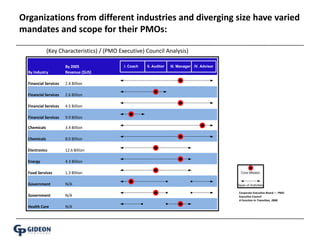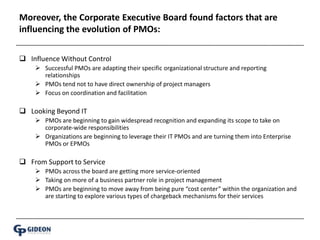PMO Overview June 2009
- 1. Program Management OfficeA Changing Organization
- 2. A Program Management Office (PMO)A PMO is a department or group that defines and maintains the standard processes for the execution of programs and projects. The PMO strives to standardize and introduce economies of repetition in the execution of projects. The PMO can serve the functions of project auditor, project manager and portfolio manager. Moreover, the PMO is the source of documentation, training, performance reporting on the practice of program/project management. Program Management Office Definition
- 3. Program and Project Management Issues:Project portfolio information is not readily available performance metrics Project impact is not trackedIncreased number and complexity of projectsIn 2008, IT expects to manage 108 new projects, not including 24 in flightThe potential for ongoing acquisitions will keep placing additional pressure on IT resources with the increasing number of projectsLoss of key resource productivityLine and IT resources spending increasing amounts of time on project management and monitoring activities, distracting them from customer activitiesProjects are not prioritized, IT resources may not be focusing on the appropriate projects, everything is just a number Projects are suffering from scope creep, increased cost and missed timelinesNot all projects have a project plan, there is no standard project approachProject planning efforts are not effectively executed on all projects leading to projects being delivered late and at a higher costProject requirements are not solidly identified in all projects before IT resources are engaged
- 4. The implementation of a PMO can have significant benefits by improving the effectiveness and efficiency of program/project portfolios: Proactive selection, prioritization and management of the program/project portfolio – “Build the right thing”Proactive identification of issues, ideas for improvement – Demand ManagementEconomies of scale in the integration of liked ideas into larger more impactful effortsImproved budgeting and estimation of program/project efforts and resource utilizationPromote efficient and effective execution program/project management – “Build things right”Improve project ROIReduced project cycle timeReduced delivery costs, delivery of projects on budgetDelivery of projects on time Improved quality of project deliverablesIncreased capitalization opportunitiesImproved project trackingReduce business and project failure risksEarly identification and proactive management of project issues and risksBetter containment and management of project scopeImprove utilization of resources – including capital, equipment and peopleAlign the right resources and identify knowledge gapsMore opportunities to leverage and reuse knowledgeImproved accuracy on the assignment and forecasting of resource utilizationReduced the time commitment of non project management resources
- 5. PMO’s are a organization in transitionCorporate Executive Board — PMO Executive Council A Function In Transition, 2006
- 6. Perpetual MotionThe number of PMOs continues to grow, mature and transition their role:…leaders of this young function…While the use of PMOs within IT grows…(Companies with PMOs) / (Percentage of Respondents, 2003)(Age of Current PMOs) / (Percentage of Respondents, 2005)4-6 years82%More than 6 years70%20%22%53%13%45%Less Than 2 Years2-4 Yearsn = 40…search for the right structure……and consider changing the role(Current and Desired Future Role for the PMO) / (Percentage of Respondents, 2006)(PMO Reorganizations) / (Percentage of Respondents, 2005)No Expected Change in Core PMO Role34%70%50%66%Corporate Executive Board — PMO Executive Council A Function In Transition, 2006Plan for Change in Core PMO Rolen = 47
- 7. Decision Making CapabilitiesBased on analysis by the Corporate Executive Board, PMOs can be grouped into four types:Effectiveness“Build the Right Thing” The “Manager”The “Advisor”Inclusive of “Coach”, “Auditor” and “Manager” functions
- 8. Supporting portfolio definition and asset allocation
- 9. Guiding portfolio prioritization decisions
- 10. Conducting business case realization audits
- 11. Inclusive of “Coach” and “Auditor” functions
- 13. Supporting project planning processThe “Coach”The “Auditor”Inclusive of “Coach” functions
- 16. Analyzing and reporting on projects
- 17. Project manager skill upscaling
- 19. Knowledge management processesEfficiency“Build Things Right”
- 20. PMO Process Decomposition PMOs differ in scope, size and level of automation; based on their maturity and desired corporate objectives. However, all will include some or all of these processes depending on their scope and objective:Program Management OfficePortfolio ManagementMethods and ToolsProject ManagementResource ManagementFinancial Management and ReportingKnowledge ManagementProcessesIdea Identification and Management
- 21. Project Approval and Funding
- 24. Tool Configuration and Deployment
- 25. Project Planning and Initiation
- 26. Project Control and SQA
- 28. Project Closure
- 30. Project Staffing
- 31. Consultant Sourcing and Management
- 33. Expense Recovery and Capitalization
- 35. Portfolio Analysis and Reporting
- 36. Training
- 37. Acquire
- 38. Develop
- 40. Disseminate and CommunicateSub - Processes
- 41. PMO Types and Organization and core mission:
- 42. Aligning PMO Competencies With the Core Mission PMOs looking to bridge gaps between current and ideal activity involvement for greater focus ManagerAdvisor
- 43. Organizations from different industries and diverging size have varied mandates and scope for their PMOs:(Key Characteristics) / (PMO Executive) Council Analysis)Corporate Executive Board — PMO Executive Council A Function In Transition, 2006
- 44. Moreover, the Corporate Executive Board found factors that are influencing the evolution of PMOs: Influence Without ControlSuccessful PMOs are adapting their specific organizational structure and reporting relationshipsPMOs tend not to have direct ownership of project managersFocus on coordination and facilitationLooking Beyond ITPMOs are beginning to gain widespread recognition and expanding its scope to take on corporate-wide responsibilitiesOrganizations are beginning to leverage their IT PMOs and are turning them into Enterprise PMOs or EPMOsFrom Support to ServicePMOs across the board are getting more service-oriented Taking on more of a business partner role in project managementPMOs are beginning to move away from being pure “cost center” within the organization and are starting to explore various types of chargeback mechanisms for their services
- 45. Types of PMO Influences (cont’)From Data to DecisionPMOs are moving beyond data-oriented project reports to more strategic, portfolio-level dashboardsPMOS are tailoring the level of information granularity to surface portfolio issuesSurfacing pertinent information, inconsistency of metrics, and the quality and validity of data also continue to be challenges to PMOsReporting will continue to be among PMOs’ top core activities65% of PMOs dedicate at least 20% or more of their time to reportingHowever, overall effectiveness of reporting remains lowNext-Generation MetricsPMOs are beginning to look beyond traditional approaches of tracking Relying more on the use of earned value (EV) metrics to track project- and program-level performanceOther PMO metrics include: earn-burn rates, project sponsor engagement tracking, project initiation cycle time, time lag between project change requests (PCRs) authorization, assessment and implementation, and average project health recovery timesThe inability to provide forward-looking visibility for senior management is one of the biggest challenges for a PMOThere are now many Portfolio Management tools availablePMOs are increasingly relying on software-based automation tools for their reporting functionMore than 95% of PMO Executive Council members surveyed indicated they rely on automated tools for tracking












